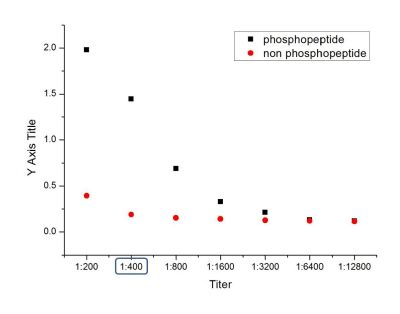上海细胞库
人源细胞系| 稳转细胞系| 基因敲除株| 基因点突变细胞株| 基因过表达细胞株| 重组细胞系| 猪的细胞系| 马细胞系| 兔的细胞系| 犬的细胞系| 山羊的细胞系| 鱼的细胞系| 猴的细胞系| 仓鼠的细胞系| 狗的细胞系| 牛的细胞| 大鼠细胞系| 小鼠细胞系| 其他细胞系|

| 规格 | 价格 | 库存 |
|---|---|---|
| 100ul | ¥ 1980 | 200 |
| 中文名称 | 磷酸化α型-过氧化酶活化增生受体抗体 |
| 别 名 | PPAR alpha (phospho-Ser12); PPAR alpha (phospho-S12); p-PPAR alpha (Ser12); p-PPAR alpha (S12); hPPAR; MGC2237; MGC2452; NR1C1; Nuclear receptor subfamily 1 group C member 1; Peroxisome Proliferator Activated Receptor alpha; PPAR; PPAR alpha; PPARA; OTTHUMP00000197740; OTTHUMP00000197741; Peroxisome proliferator-activated receptor alpha; PPAR-alpha; PPARA_HUMAN; PPARalpha. |
| 产品类型 | 磷酸化抗体 |
| 研究领域 | 肿瘤 细胞生物 免疫学 转录调节因子 激酶和磷酸酶 |
| 抗体来源 | Rabbit |
| 克隆类型 | Polyclonal |
| 交叉反应 | Human, Mouse, Rat, (predicted: Dog, Pig, Cow, Horse, Guinea Pig, ) |
| 产品应用 | WB=1:500-2000 ELISA=1:500-1000 IHC-P=1:100-500 IHC-F=1:100-500 IF=1:100-500 (石蜡切片需做抗原修复) not yet tested in other applications. optimal dilutions/concentrations should be determined by the end user. |
| 分 子 量 | 52kDa |
| 细胞定位 | 细胞核 |
| 性 状 | Liquid |
| 浓 度 | 1mg/ml |
| 免 疫 原 | KLH conjugated Synthesised phosphopeptide derived from human PPAR alpha around the phosphorylation site of ser12:PL(p-S)PL |
| 亚 型 | IgG |
| 纯化方法 | affinity purified by Protein A |
| 储 存 液 | 0.01M TBS(pH7.4) with 1% BSA, 0.03% Proclin300 and 50% Glycerol. |
| 保存条件 | Shipped at 4℃. Store at -20 °C for one year. Avoid repeated freeze/thaw cycles. |
| PubMed | PubMed |
| 产品介绍 | Peroxisome proliferators are nongenotoxic carcinogens which are purported to exert their effect on cells through their interaction with members of the nuclear hormone receptor family, termed Peroxisome Proliferator Activated Receptors (PPARs). Nuclear hormone receptors are ligand dependent intracellular proteins that stimulate transcription of specific genes by binding to specific DNA sequences following activation by the appropriate ligand. Studies indicate that PPARs are activated by peroxisome proliferators such as clofibric acid, nafenopin, and WY-14,643, as well as by some fatty acids. It has also been shown that PPARs can induce transcription of acyl coenzyme A oxidase and cytochrome P450 A6 (CYP450 A6) through interaction with specific response elements. PPAR alpha is activated by free fatty acids including linoleic, arachidonic, and oleic acids. Induction of peroxisomes by this mechanism leads to a reduction in blood triglyceride levels. PPAR alpha is expressed mainly in skeletal muscle, heart, liver, and kidney and is thought to regulate many genes involved in the beta-oxidation of fatty acids. Activation of rat liver PPAR alpha has been shown to suppress hepatocyte apoptosis. PPAR alpha, like several other nuclear hormone receptors, heterodimerizes with retinoic X receptor (RXR) alpha to form a transcriptionally competent complex. Function: Ligand-activated transcription factor. Key regulator of lipid metabolism. Activated by the endogenous ligand 1-palmitoyl-2-oleoyl-sn-glycerol-3-phosphocholine (16:0/18:1-GPC). Activated by oleylethanolamide, a naturally occurring lipid that regulates satiety (By similarity). Receptor for peroxisome proliferators such as hypolipidemic drugs and fatty acids. Regulates the peroxisomal beta-oxidation pathway of fatty acids. Functions as transcription activator for the ACOX1 and P450 genes. Transactivation activity requires heterodimerization with RXRA and is antagonized by NR2C2. Subunit: Heterodimer; with RXRA. This heterodimerization is required for DNA binding and transactivation activity. Interacts with AKAP13, LPIN1 and PRDM16. Also interacts with PPARBP coactivator in vitro. Interacts with CITED2; the interaction stimulates its transcriptional activity (By similarity). Interacts with NCOA3 and NCOA6 coactivators. Interacts with ASXL1 AND ASXL2. Subcellular Location: Nucleus. Tissue Specificity: Skeletal muscle, liver, heart and kidney. Similarity: Belongs to the nuclear hormone receptor family. NR1 subfamily. Contains 1 nuclear receptor DNA-binding domain. SWISS: Q07869 Gene ID: 5465 Database links: Entrez Gene: 5465 Human Entrez Gene: 19013 Mouse Entrez Gene: 25747 Rat Omim: 170998 Human SwissProt: Q07869 Human SwissProt: Q6I9S0 Human SwissProt: P23204 Mouse SwissProt: Q542P9 Mouse SwissProt: P37230 Rat Unigene: 103110 Human Unigene: 710044 Human Unigene: 212789 Mouse Unigene: 9753 Rat Important Note: This product as supplied is intended for research use only, not for use in human, therapeutic or diagnostic applications. |
| 产品图片 |  Sample: Sample:Liver (Rat) Lysate at 40 ug Primary: Anti-phospho-PPAR alpha (Ser12) (bs-4055R) at 1/300 dilution Secondary: IRDye800CW Goat Anti-Rabbit IgG at 1/20000 dilution Predicted band size: 52 kD Observed band size: 52 kD  Sample: Sample:Heart (Mouse) Lysate at 40 ug Liver (Mouse) Lysate at 40 ug Primary: Anti-phospho-PPAR alpha (Ser12) (bs-4055R) at 1/300 dilution Secondary: IRDye800CW Goat Anti-Rabbit IgG at 1/20000 dilution Predicted band size: 52 kD Observed band size: 52 kD  Sample: Sample:Colon carcinoma (Human) Lysate at 40 ug Embryo (Mouse) Lysate at 40 ug Primary: Anti- phospho-PPAR alpha (Ser12) (bs-4055R) at 1/300 dilution Secondary: HRP conjugated Goat-Anti-rabbit IgG (bs-0295G-HRP) at 1/5000 dilution Predicted band size: 52 kD Observed band size: 52 kD  Sample: Sample:Lane 1: Heart (Mouse) Lysate at 40 ug Lane 2: Liver (Mouse) Lysate at 40 ug Lane 3: Kidney (Mouse) Lysate at 40 ug Lane 4: Cerebrum (Mouse) Lysate at 40 ug Lane 5: Cerebrum (Rat) Lysate at 40 ug Lane 6: Jurkat (Human) Cell Lysate at 30 ug Lane 7: A431 (Human) Cell Lysate at 30 ug Primary: Anti-phospho-PPAR alpha (Ser12) (bs-4055R) at 1/1000 dilution Secondary: IRDye800CW Goat Anti-Rabbit IgG at 1/20000 dilution Predicted band size: 53 kD Observed band size: 50 kD  Tissue/cell: rat kidney tissue; 4% Paraformaldehyde-fixed and paraffin-embedded; Tissue/cell: rat kidney tissue; 4% Paraformaldehyde-fixed and paraffin-embedded;Antigen retrieval: citrate buffer ( 0.01M, pH 6.0 ), Boiling bathing for 15min; Block endogenous peroxidase by 3% Hydrogen peroxide for 30min; Blocking buffer (normal goat serum,C-0005) at 37℃ for 20 min; Incubation: Anti-phospho-PPAR alpha(Ser12) Polyclonal Antibody, Unconjugated(bs-4055R) 1:200, overnight at 4°C, followed by conjugation to the secondary antibody(SP-0023) and DAB(C-0010) staining  phosphopeptide non phosphopeptide phosphopeptide non phosphopeptide |